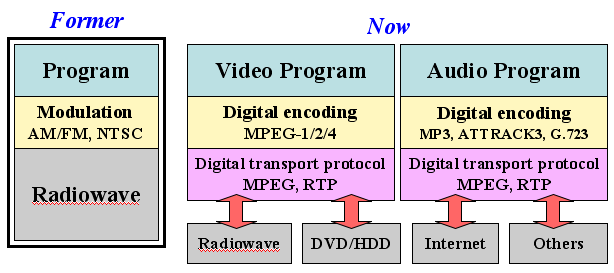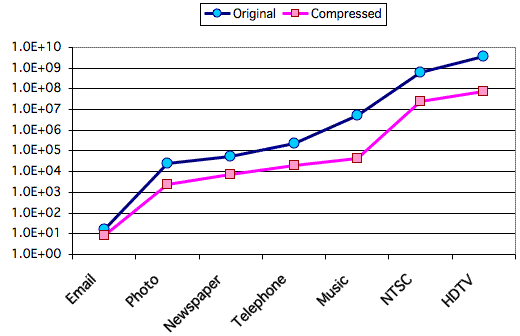Convergence of Telecom &
Broadcast, |
Cat: ICT |
|
Wataru Kameyama |
05z31u/18215r |
Title
Conversion of Telecom & Broadcast,
and Contents Circulation
通信・放送の融合とコンテンツ流通
Author
Wataru Kameyama
亀山渉
Published
Dec.12, 2005
2005/12/12
Index
Intro
- Summary of the presentation at IECP of Glocom, International Univ.
of Japan by Prof. Wataru Kameyama of Waseda Univ.
- 国際大学GlocomのIECP研究会での亀山渉早大大学院国際情報通信研究科教授によるプレゼンテーションのサマリーである。
Resume
要約
>Top 1. Background and trend:
- Contents had been circulated within physical constraints of media.
- Now, contents have become free from the restriction of media owing
to the advent of multimedia coding
technology and digital
transport technology.
- Thus technical platform is getting available for independent circulation
of contents.
- What is contents?
- The term of 'contents' diffused since 21C.
- Coding and transport protocol technology enabled contents
to be separated from media.
- Change comes out from audio data:
- CD Audio (16 bit sampling stereo, PCM): 1.5Mbps
- NTSC or PAL (SDTV): 150 Mbps
- HDTV: 1Gbps
1. 背景と動向:
- コンテンツはメディアの物理的制約の範囲内で流通していた。
- これに対し、マルチメディア符号化技術 (=マルチメディア圧縮技術)
とデジタル伝送技術によって、コンテンツをメディアから開放する。
- これによってコンテンツは単体で流通する技術基盤が整いつつある。
- コンテンツとは?:
- コンテンツ用語は21世紀になって広く使用された。
- 符合化・圧縮技術と伝送技術がコンテンツをメディアから分離した。
- 音声に最初の変化が訪れた。
- CD Audio (16 bit sampling stereo, PCM): 1.5Mbps
- NTSC or PAL (SDTV): 150 Mbps
- HDTV: 1Gbps
>Top 2. Relation of Media and Contents of Radio/TV:

- Burst of application such as radio program, music distribution,
call signals with melodies, iPod/iTune, Internet radio, etc.
2. ラジオ・TVにみるメディアとコンテンツの関係
- 左図は、昔の一体化した状態から、現在のコンテンツは媒体を選ばない状態を示す。
- アプリの爆発
- ラジオ番組
- 音楽配信
- 着メロ
- iPod/iTunes
- インターネットラジオ
>Top 3. Data volume of
typical contents:
- Email : 16 Kbit
16bit/character x 1000
- Photo: 24 Mbit
RGB 8bit x 100 pixel x 1000 pixel
- Newspaper: 53 Mbit
(16bit/chra x 14000 + 8 bit x 500 x 500) x 24 pages
- Telephone (1hour): 230 Mbit
8bit x 8000 Hz x 60 x 60
- Music (1hour): 5.1 Gbit
16bit x 2 channel x 44100 Hz x 60 x 60
- TV (NTSC, 1hour): 600 Gbit
16bit x 480pixel x 720pixel x 29.97frame x 60 x 60
- HDTV (1hour): 3.6 Tbit
16bit x 1080 x 1920 x 29.97frame x 60 x 60
3b.Data Compression:
- Email: 1/2 by zip = 8 Kbit
- Photo: 1/10 by JPEG = 2.4 Mbit
- Newspaper: 1/2 by ZIP and 1/10 by JPEG = 2.5 Mbit character +
4.8 Mbit Photo = 7.5 Mbit
- Telephone (1hour): 1/12 by MP3 = 19 Mbit
- Music (1hour): 1/12 by MP3 = 43 Mbit
- TV (NTSC, 1hour): 1/25 by MPEG2 = 24 Gbit
- HDTV (1hour): 1/50 by MPEG2 = 72 Gbit
>Top 4. Effect of data compression: Unit:
bit (CSV data)
-

4b. Data volume of
typical media:
- FD: 12Mbit
1.44Mbyte x 8
- Tel line (1hour): 200Mbit
56Kbit/sec x 60 x 60
- CD: 5.2 Gbit
650Mbyte x 8
- ADSL (1hour): 35 Gbit
10Mbit/sec x 60 x 60
- DVD: 38 Gbit
4.7 Gbyte x 8
- TV wave 1 channel (1hour): 108 Gbit
30 Mbit/sec x 60 x 60
- LAN (100BastT, 1hour): 360 Gbit
100 Mbit/sec x 60 x 60
>Top 5. Birth of contradiction:
- Deterioration by copy of analog content:
- Video copy by VHS, and audio copy by cassette tape have been
allowable by the copyright holder.
- No distribution could be supposed beyond media.
- Analog expression and the media on which keeps a record has
been fixed:
- Character on a paper
- Photo on a glossy paper
- Sound on wave/magnetic tape
- Movie on wave/magnetic tape
- Business model on such contradiction:
- If a record/CD gets hurt, another record/CD will be sold.
- Radio/TV is heard on live.
- Legislative preparations are behind of rapidly growing technology.
- 'Listen to the radio' should be 'listen to the voice via radio.'
- 'Watch the TV' should be 'watch the program via TV.'
- 'Media is a mass communications industry'
- In 1985 Telecom Business Law in Japan segments: Type-I carrier
who owns media, and Type-II doesn't.
5. 矛盾の誕生:
- アナログのコンテンツのコピーは劣化
- VHSやテープは著作権によって許容
- メディアを超えてコンテンツが流通しない前提
- 文字
- 写真
- 音
- 映像
- メディアの特性をビジネスモデルに利用
- レコードやCDが傷つくと買い直しとなる
- ラジオやTVは生放送
- 法律は技術進歩の後追い
- 第一種/第二種通信事業者の区別
>Top 6. Why convergence
does not promote?:
- i-mode:
- arbitrary site is preferable for DoCoMo.
- Because DoCoMo gains by the use of network.
- TV:
- broadcast by other TV channel could be impossible.
- Audience rate matters
- "Convergence of telecom and broadcast is one-side love
from telecom side."
- Why broadcast has been monopolistic service?:
- Radio wave had been the only media which can transmit TV signals;
SDTV (Standard Definition TV) requires 6MHz bandwidth.
- TV Set had been the only device which can receive analog modulated
TV signals.
- Coverage of the radio is limited, which requires to avoid
interference.
- Thus TV media industry had survived as the king of media;
could be the last monopolized industry.
- Since 21C, such differencia shows its seams, because digital
technology accelerated affinity of computer and TV.
- Users now feel no difference of telecom and broadcast.
- "VOD" Video On Demand showed unsuccessful solution
in 1990s.
- The solution would be:
- PDR (Personal Digital Recorder
- PVR (Personal Video Recorder
- DVR (Digital Video Recorder)/HDR ( could be HDTV Recorder,
or High Data Rate?
6. なぜ融合が進まないのか?
- i-mode:
- 勝手サイトは歓迎
- 通信会社は通信回線を利用してもらうことで収益を得る
- TV:
- 他局での放送は論外
- 視聴率が収益の基本
- "通信と放送の融合は通信側からの一方的な片思い"
- なぜ放送は独占的サービスか
- 電波だけがTV信号を伝送できた。
- TVセットだけがアナログ変調されたTV信号を受信可能
- TV局は最後の独占企業
- ユーザは今や通信と放送の区別はない。
- VODは90年代に失敗した。
- 解としては、
- PDR
- PVR
- DVR/HDR
>Top 7. Media which can
distribute rich contents:
- Broadcast wave: Satellite and terrestrial wave
- Cable
- Broadband network: IP
- Mobile phone: 3G/4G
- Disk: BD, HD-DVD
- Memory: HDD, Flash memory
7. リッチコンテンツを配信できるメディア:
- 放送波: 衛星、地上波の電波
- CATV
- ブロードバンド: IP
- 携帯: 3G/4G
- ディスク: BD, HD-DVD
- メモリー: HDD, Flash memory
>Top 8. History repeats itself:
- 50 yeas ago: when TV broadcast started, travel industry strongly
opposed.
- In early 1970s: when R
showed prototype of VCR with audience restrictions, Disney strongly
opposed.
- Then, SONY was sued in US due to VCR and copyright controversy.
- In 1982: MPA (Motion Pictures Association of US) lobby to impose
on VCR maker as compensation for CM skip.
- and to be continued ...
8.歴史は繰り返す:
- 50年前:放送が始まった時、旅行業界は大反対
- 1970年代初期:RCAが視聴制限機能付きVCRの原型を見せた際、Disneyは絶対反対
- SONYは何年も米国でVCRと著作権の論争で訴訟
- 1982年:MPA会長がCM Skipの補償費用をVCR メーカに上乗せしようとロビー活動展開
- さらに歴史は続く...
Comment
- At last I decided to abandon to make full bilingual text, because
it takes more than double time (except this). Instead I will try
to enrich the contents and upload more quickly.
- But I will try to add some abbreviated explanation with about
half of the information content in Japanese.
- I think abridged Japanese (almost into half) could be enough for Japanese natives.
- ついに完全バイリンガル文章を作るのを (この文を除き) 諦めた。理由は2倍以上の時間がかかるからである。その代わり内容の充実を図りアップロードの迅速化を図る。
- 但し、日本語で情報量が半分位の簡略の説明を追加するようにする。
- 日本語を半分に省略しても日本人には十分と思う。
Title |
Conversion of Telecom & Broadcast,
|
通信・放送の融合とコンテンツ流通 |
Author |
Wataru Kameyama |
亀山渉 |
Published |
Dec.12, 2005 |
2005/12/12 |
Index |
||
Intro |
|
|
Resume |
要約 |
>Top 1. Background and trend:
|
1. 背景と動向:
|
>Top 2. Relation of Media and Contents of Radio/TV:
|
2. ラジオ・TVにみるメディアとコンテンツの関係
|
>Top 3. Data volume of typical contents:
|
3b.Data Compression:
|
>Top 4. Effect of data compression: Unit: bit (CSV data) |
4b. Data volume of typical media:
|
>Top 5. Birth of contradiction:
|
5. 矛盾の誕生:
|
>Top 6. Why convergence does not promote?:
|
6. なぜ融合が進まないのか?
|
>Top 7. Media which can distribute rich contents:
|
7. リッチコンテンツを配信できるメディア:
|
>Top 8. History repeats itself:
|
8.歴史は繰り返す:
|
Comment |
|
|